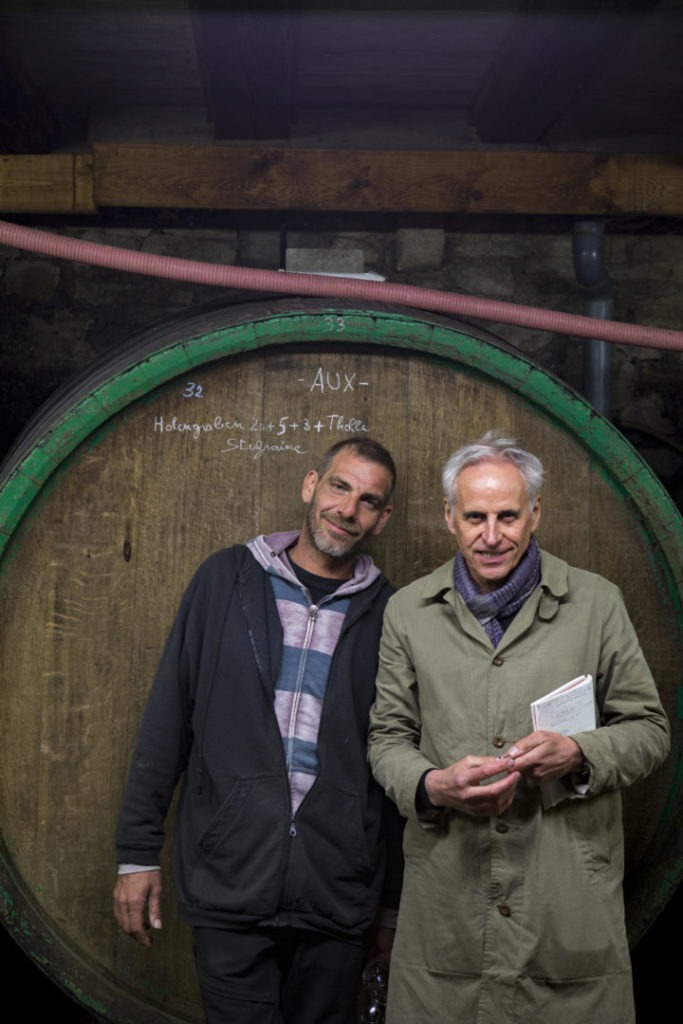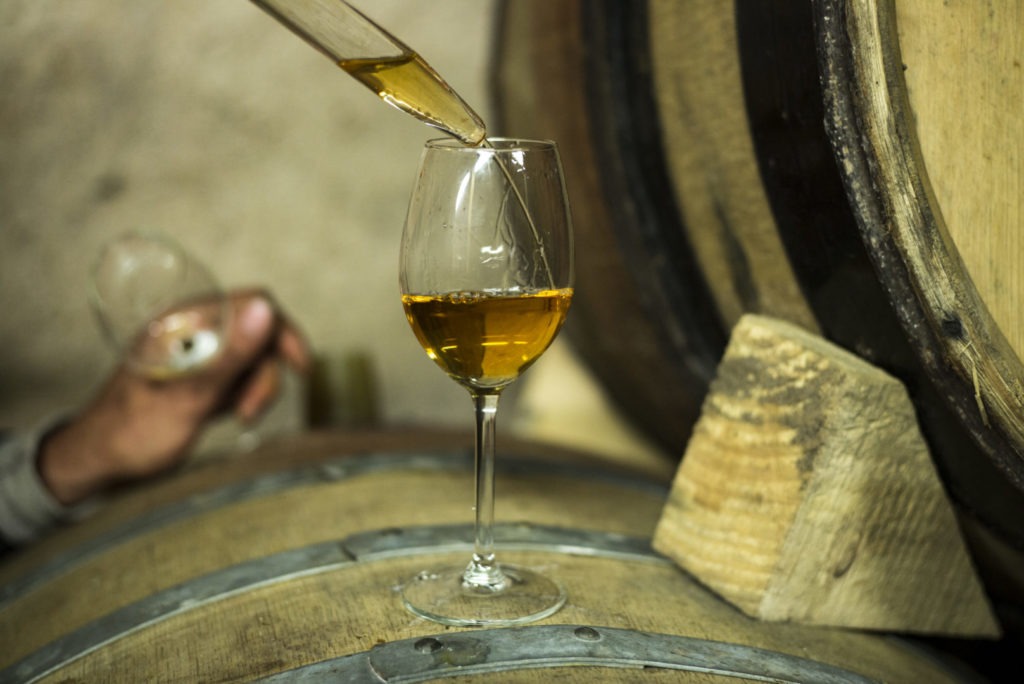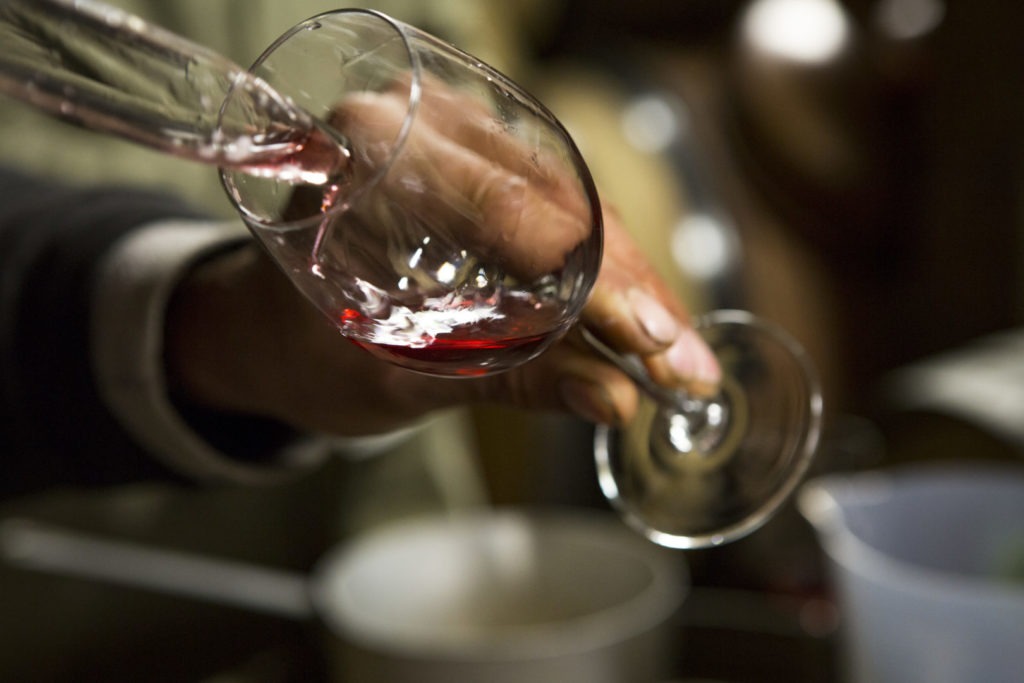Jean-Marc DREYER – Rosheim
We were in and out of Jean-Marc’s winery and vineyards during the 2018 harvest. It was energising to experience the buzz around the grapes coming in, somewhat fast and also in bigger quantities than the last few years. The winery, a hive of activity with the initial storage and crush pads being juggled to cope with the bins of hand- picked fruit stacking up. The energy, camaraderie and constant joking of the picking crew, needing fed and “watered” in the vineyards and lunched in the courtyard. Then a quiet and stillness set in as the early morning snipping of grape bunches got underway.
The Location
The winery is located in Rosheim, 25km south west of Strasbourg. A bustling town of 5,000; with a hospital, a monastery, soaring medieval towers and even a few buildings remaining from the 12th century. You can dine in the Rosenmeer restaurant with its Michelin star and the town has also produced a Noble Prize winner in Chemistry. The Mairie (town hall) web site lists the open days for game hunting in the surrounding forests and also a form to order winter firewood from the municipal forest. A country town with its winding streets packed tight with half-timber and grés des Vosges (local red sandstone) buildings, with a culture situated between today and deep history.
– the signposts marked “j. m. Dreyer” and the Agriculture Biologique logo “AB”, indicating that the products are 100% certified organic –
The Dreyer winery sits in amongst this, in the same section as the monastery and hospital. The winery is a complex of structures built around a large courtyard, which you enter via two gigantic wooden doors. Inside the courtyard there is a myriad of doors that lead to cellars, storerooms, houses, offices, old stables and sheds. Outside, there is the luxury of three parking spaces allocated by the town hall. Each with neat signposts marked “j. m. Dreyer” and the Agriculture Biologique logo “AB”, indicating that the products here are 100% certified organic. You know, it’s just what it says on the tin.
The Winemaker
 There is always a warm welcome from Jean-Marc and his conjointe Claudine, whether it’s on an early spring evening when a long tasting session unfolds into the cold night. Whether it’s a rapid pit stop to pick up bottles for a friend, or a disruptive drop in with strangers, during a busy wine harvest morning.
There is always a warm welcome from Jean-Marc and his conjointe Claudine, whether it’s on an early spring evening when a long tasting session unfolds into the cold night. Whether it’s a rapid pit stop to pick up bottles for a friend, or a disruptive drop in with strangers, during a busy wine harvest morning.
Jean-Marc went through a BTS at the local Obernai wine school and sharpened his approach and attitude with a “stage d’installation” with Patrick Meyer in nearby Nothalten. Patrick is one of the pioneers of the natural wine scene in Alsace and France, and you can check an interview he did with Back In Alsace – right here.
From these very local influences, Jean-Marc moved into a widespread network of close friends where ideas and experiences cross mingle and get shaken up. Shaken up and thought about. In this “bande des copains” outside of Alsace, he has mentioned Patrick Bouju in the Auvergne, Jean-Louis Pinto near Limoux and Raphael Beysang, recently installed in Beaujolais. Winemakers who are producing relevant wines for a public interested in where the wine comes from, how the vineyards are managed and what goes on in the cellar. A public with little interest in consumer test comparisons and daft scoring systems out of 20 or a 100. It’s another take on zero-zero wines, with zero interest given to some meaningless number. A public that have had it with closed up and dead industrial wines.
The Vineyards and the Wines
The vineyards range over 6 hectares and are split between 25 parcelles dotted around the hillsides that surround Rosheim. The soils are predominately a clay limestone mix (argilo-calcaire). The St. Jacques Pilgrims Way winds past to the north of Rosheim, right through one of Jean-Marc’s Pinot Gris plots. The symbol that is associated with St. Jacques is the scallop shell and its sort of neat that scallop fossils turn up in Alsace’s limestone vineyards. Fossil deposits that date back 50 million years.
“Don’t mix up what you need, with what the wine needs.”
The conversion of the domain to biodynamics started in 2003 when the first Steiner directed preparations were used. Jean-Marc didn’t go for full certification for several years, but he made that step in 2014. No new parcelles have been planted for 15 years, with the emphasis more on cultivating and developing the maturing vineyards to express their potential. There is no Grand Cru big name vineyard close to Rosheim, so no resting on the laurels of some name-tag. The success and reputation of these wines comes from the recognition of their quality and their relevance to the growing public interested in natural wine.
Part of the domain is currently worked by horse and Jean-Marc plans to increase this as he sees the approach contributing to the balance and the energy in the vineyards. At harvest time there is emphasis on getting started in the vines early, to capture the energy and freshness of the morning. There is an on-going search for equilibrium across the whole setup and no drive towards, bigger and faster.
Annual production is around 20,000 bottles with 70% going to export; approximately 40% to Denmark, Netherlands, Belgium and Sweden; 20% to Japan and 10% to the U.S.A. That last market is where the Brutal cuveé is exported in collaboration with Les Vins Pirouettes. More on this some other time.
During a series of visits in the last 18 months we tasted a wide range of wines from 2012 to 2017; bottled, newly bottled, from the barrique and from the foudre. The 2017 wines are now appearing on the market in the various corners of the planet. The list is made up of seven, white grape varietal maceration cuvées, termed the ORIGIN series (Sylvaner, Auxerrois, Riesling, Muscat and Gewürztraminer). Plus the Pinot Noir Elios, raised in large foudres and the Pinot Noir Anigma raised in barriques.
We also got lucky at the end of 2018 and had the chance to taste the complete range of available wines, at the Cheribibi restaurant and wine bar in Biarritz. Big thanks to the owner, Francois Lemarié, for hosting. It was good fun to open and taste wines from the North-East, way down in the South-West of France. A ‘diagonal tasting’ to put a different angle on the usual vertical and horizontal approaches.
An early developer from 2018 is already out there; Pink Pong a Pinot Noir/Pinot Gris maceration. We tasted the 2016 in spring 2017, with a nose that was in line with a rosé, with more weight on tasting with red fruits and a hint of spices.
The five maceration “Origin” wines go through 10-20 days with skin contact depending on the rhythm of fruit coming in during harvest.
There was no Pinot Gris production in 2017 due to early frosts and that explains the lack of this variety in the current release of wines.
The wines were all clear with a light golden orange touch. The Sylvaner had quince on the bouquet and was round, big and dry on tasting. The Muscat had a typical, fruity grape nose and a delicate dry and balanced fruity acidity. The Riesling was fascinating with a sort of tension between a tight vertical structure and a wide horizontal softness. It was super dry on the finish with a resonance of green fruits and just-right acidity. The Gewurztraminer was definitely in the orange wine colour range, with discrete and delicate tropical fruits on the nose, and a huge burst of ripe mango on tasting, which closed down to a long dry finish.
Apart from the Anigma Pinot Noir which will easily develop another two or three years, the range of the maceration wines are nicely balanced on an elegant edge with good weight and a great energy and tension between expressive fruit and a roundness from the skin contact. These are wines that are delicious to drink now and in the next 18 months. It will be interesting to see how they will develop beyond that, if there are any left around.
The two 2017 release, direct press, wines are blends from different years. The TriAux is a blend of Auxerrois from 2015, 2016, 2017 and bottled in August 2018. We loved this – clear and pale, touch of cinnamon and yeast on the nose, with a round and crunchy body and dry salinity and complex white fruits on the finish. A wine with character and energy. The second direct press wine, the cuveé Brutus, is a 2016 Pinot Gris, blended with 2013 and 2016 Auxerrois. This was super clear for a non filtered wine, with just a touch of reduction on the nose. The wine had a weighty roundness and body to it on tasting, with all sorts of dried fruits on a long dry finish.
There is a certain touch of Zen around the whole approach here and Jean-Marc lays this out in his own gentle way. “Don’t mix up what you need, with what the wine needs. Focus on the vineyards, and focus on the rhythms of the harvest. The most important intervention of the winemaker is bringing in the best quality grapes.” Then the path goes to maceration or direct press, with the grape juice moved to barriques or into large Alsace oak foudres. Then its patience during the winter period as fermentations kick in, fade out, kick in, fade out and the wine settles. The target is to ferment right through to a dry finish. The patience may go long as some wines kick back into fermentation in the spring. Some wines take even longer to settle out various degrees of reduction and volatility. The approach is indigenous yeasts, no additives introduced at any stage of winemaking, and no filtration. Natural Wine if that is what you want to call it. Wine with attitude and relevance is what we call it.
Jean-Marc Dreyer is a great example of modern Alsace winemaking. Shaking off any vestige of Alsace monotony and throwing his energy into a fascinating translation of these traditional varieties. His wines have character, life and soul.
 Feeling Humble – Rocking and Rolling in Rosheim with Jean-Marc on a cold spring night
Feeling Humble – Rocking and Rolling in Rosheim with Jean-Marc on a cold spring night
Jean-Marc DREYER
20,000 bottles
8, rue de la Marne
67560 ROSHEIM, France
+33 (0)3 88 48 06 93





